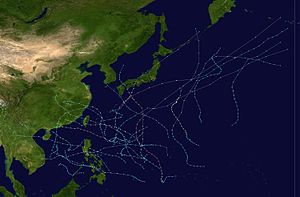
Back 1975年の台風 Japanese 1975년 태풍 Korean Temporada de tufões no Pacífico de 1975 Portuguese ฤดูพายุไต้ฝุ่นแปซิฟิก พ.ศ. 2518 Thai Mùa bão Tây Bắc Thái Bình Dương 1975 Vietnamese 1975年太平洋颱風季 Chinese
| 1975 Pacific typhoon season | |
|---|---|
 Season summary map | |
| Seasonal boundaries | |
| First system formed | January 20, 1975 |
| Last system dissipated | December 30, 1975 |
| Strongest storm | |
| Name | June |
| • Maximum winds | 295 km/h (185 mph) (1-minute sustained) |
| • Lowest pressure | 875 hPa (mbar) |
| Seasonal statistics | |
| Total depressions | 39 |
| Total storms | 21 |
| Typhoons | 14 |
| Super typhoons | 3 (unofficial) |
| Total fatalities | >229,166 (Deadliest Pacific typhoon season on record) |
| Total damage | > $1.35 billion (1975 USD) |
| Related articles | |
The 1975 Pacific typhoon season was one of the deadliest tropical cyclone seasons on record, with nearly 229,000 fatalities occurring during the season. It had no official bounds; it ran year-round in 1975, but most tropical cyclones tend to form in the northwestern Pacific Ocean between June and December. These dates conventionally delimit the period of each year when most tropical cyclones form in the northwestern Pacific Ocean.
Tropical Storms formed in the entire west pacific basin were assigned a name by the Joint Typhoon Warning Center. Tropical depressions in this basin have the "W" suffix added to their number. Tropical depressions that enter or form in the Philippine area of responsibility are assigned a name by the Philippine Atmospheric, Geophysical and Astronomical Services Administration or PAGASA. This can often result in the same storm having two names.
Some of the notable storms here are Typhoon Nina, which caused the Banqiao Dam flood, which resulted in approximately 126,000 people dead, and Typhoon June, which was the strongest storm on record with a pressure of 875 mbar, until beaten by Typhoon Tip in 1979 with 870 mbar.